
Spelman College is a private, historically Black, women's liberal arts college in Atlanta, Georgia. It is a founding member of the Atlanta University Center academic consortium. Founded in 1881 as the Atlanta Baptist Female Seminary, Spelman awarded it first college degrees in 1901 and is the oldest private historically Black liberal arts institution for women.
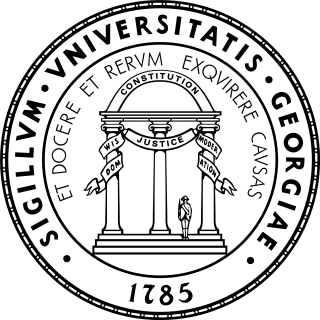
The University of Georgia is a public land-grant research university with its main campus in Athens, Georgia. Chartered in 1785, it is one of the oldest public universities in the United States. It is the flagship school of the University System of Georgia.
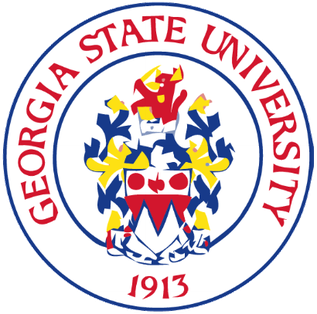
Georgia State University is a public research university in Atlanta, Georgia. Founded in 1913, it is one of the University System of Georgia's four research universities. It is also the largest institution of higher education by enrollment based in Georgia and one of the largest in the nation with a student enrollment of around 52,000, including approximately 33,000 undergraduate and graduate students at the main campus downtown.

Utah Tech University (UT), formerly known as Dixie State University (DSU) and similar names, is a public university in St. George, Utah. The university offers master's degrees, bachelor's degrees, and associate degrees. As of fall 2022, there are 12,556 students enrolled at UT.

Autherine Juanita Lucy was an American activist who was the first African-American student to attend the University of Alabama, in 1956. Her expulsion from the institution later that year led to the university's President Oliver Carmichael's resignation. Years later, the University admitted her as a master's student and in 2010 a clock tower was erected in her honor on its campus.
Xernona Clayton Brady is an American civil rights leader and broadcasting executive. During the Civil Rights Movement, she worked for the National Urban League and Southern Christian Leadership Conference, where she became involved in the work of Dr. Martin Luther King Jr. Later, Clayton went into television, where she became the first African American from the southern United States to host a daily prime time talk show. She became corporate vice president for Turner Broadcasting.
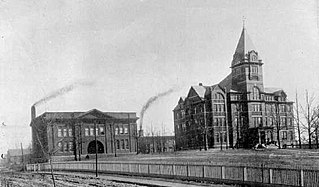
The history of the Georgia Institute of Technology can be traced back to Reconstruction-era plans to develop the industrial base of the Southern United States. Founded on October 13, 1885, in Atlanta as the Georgia School of Technology, the university opened in 1888 after the construction of Tech Tower and a shop building and only offered one degree in mechanical engineering. By 1901, degrees in electrical, civil, textile, and chemical engineering were also offered. In 1948, the name was changed to the Georgia Institute of Technology to reflect its evolution from an engineering school to a full technical institute and research university.

The Georgia Institute of Technology is a public research university and institute of technology in Atlanta, Georgia. Established in 1885, it is part of the University System of Georgia and has satellite campuses in Savannah, Georgia; Metz, France; Shenzhen, China; and Singapore.
Brian Hanlon is a classically trained master sculptor and founder of Hanlon Sculpture Studio. He has created over 550 public and private art pieces since 1987. Hanlon is a nationally acclaimed artist from Toms River, New Jersey, specializing in commissioned larger-than-life-size, to-scale bronze sculptures, reliefs, trophies, plaques and awards. He is known for developing a distinguishable style of movement in contemporary American realism sculpture.
James "Jim" Edward Dull was dean of students of Georgia Institute of Technology from 1964 to 1991. Dull was instrumental in the peaceful integration of Georgia Tech, and he oversaw many improvements with student life during his tenure at Georgia Tech.

The main campus of the Georgia Institute of Technology occupies part of Midtown Atlanta, primarily bordered by 10th Street to the north, North Avenue to the south, and, with the exception of Tech Square, the Downtown Connector to the East, placing it well in sight of the Atlanta skyline. In 1996, the campus was the site of the athletes' village and a venue for a number of athletic events for the 1996 Summer Olympics. The construction of the Olympic Village, along with subsequent gentrification of the surrounding areas, significantly changed the campus.
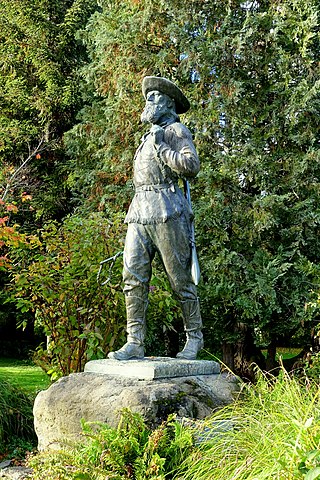
The Pioneer is a thirteen-foot-tall bronze sculpture formerly located on the University of Oregon campus in Eugene, Oregon, United States. It was the artistic work of Alexander Phimister Proctor, commissioned by Joseph Nathan Teal, a Portland attorney. A ceremony celebrated its unveiling on May 22, 1919. It included attendance from persons all across the state, the majority of enrolled students, and a special section of the crowd was reserved for the remaining settlers. T. G. Hendricks and his granddaughter removed the canvas cover, unveiling the statue. As of June 13, 2020, the statue is no longer standing on the University of Oregon campus.
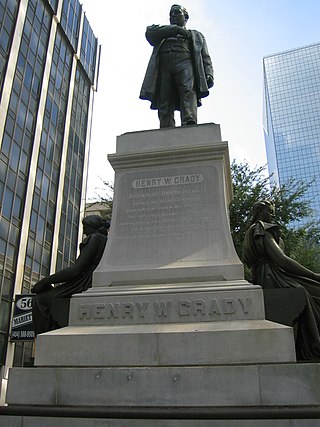
The Henry W. Grady statue is a monumental statue of Henry W. Grady in Atlanta, Georgia, United States. Built by Alexander Doyle in 1891, the statue lies at the intersection of Marietta Street and Forsyth Street in downtown Atlanta and was unveiled shortly after Grady's death in 1889. The statue has recently been the subject of controversy, as several groups have called for its removal due to Grady's support of white supremacy.

Continuing the Conversation is a public sculpture honoring Rosa Parks in Atlanta, Georgia, United States. Located on the main campus of the Georgia Institute of Technology, the artwork was created by Martin Dawe and unveiled in 2018.

The First Graduate is a bronze sculpture at the Georgia Institute of Technology. Unveiled in 2019, the statue was designed by Martin Dawe and honors Ronald Yancey, the first African American student to graduate from the institute. The sculpture is located inside the Clough Undergraduate Learning Commons.

A statue of James Meredith stands on the campus of the University of Mississippi in Oxford, Mississippi, United States. The statue honors Meredith, a civil rights activist who integrated the university in 1962. The statue was dedicated in 2006 and is located near a portal, which collectively make up the Civil Rights Monument.

Hope Moving Forward is a public monument in Atlanta, Georgia, United States. Dedicated in 2021, the monument consists of a bronze statue of Martin Luther King Jr. designed by Basil Watson atop a pedestal. It is located at the intersection of Northside Drive and Martin Luther King Jr. Drive.















